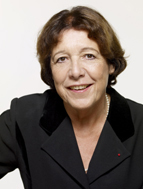Catherine Bréchignac
- Physique
- Comité de prospective en énergie
- Comité science et métrologie
- Comité science, éthique et société
- Comité histoires des sciences et épistémologie
- Comité d'Alembert
Delegate of the Physics section

- Comité de prospective en énergie
- Comité science et métrologie
- Comité science, éthique et société
- Comité histoires des sciences et épistémologie
- Comité d'Alembert
- Physique
Biography
Catherine Bréchignac is a research director at the CNRS.
Catherine Bréchignac is a specialist in atomic physics at the frontiers of nuclear physics and molecular physics, where the contribution of knowledge in one discipline can be decisive in advancing the understanding of the other.
Education and career
1967 Graduated from École normale supérieure (Fontenay-aux-Roses)
1971 Agrégée de Sciences physiques
1977 Docteur ès sciences, PhD, université Paris-Sud
1971-1978 Research associate at CNRS
1978-1985 Research associate at CNRS
1979-1980 Research associate at the Institute of Astrophysics in Ottawa (Canada)
1985-1991 Research director 2nd class at CNRS
1987 Visiting professor at the École polytechnique fédérale de Lausanne
1991-1998 Directeur de recherche 1e classe au CNRS
1998- Directeur de recherche classe exceptionnelle au CNRS
2001-2002 Adjunct Professor Georgia Tech University
2002-2006 Distinguished Visiting Scholar Professorship at Georgia Tech University
Performed functions
1985-1989 Chargée de mission at CNRS (Physical sciences and mathematics department)
1989-1995 Director of the CNRS Aimé Cotton laboratory in Orsay)
1995-1997 Scientific Director of the CNRS Physical Sciences and Mathematics Department)
1997-2000 Director General of the CNRS)
2002-2006 President of the Institut d'optique)
2004-2009 President of the Board of Directors of the Palais de la Découverte)
2006-2010 President of the CNRS)
2006-2010 Director of Renault SA)
2006-2012 Member of the Advertising Ethics Council of the French Advertising Standards Authority (ARPP))
2008-2011 President of the International Council for Science (ICSU))
2009-2011 President of the French High Council for Biotechnology)
2010- Ambassador Delegate for Science, à la technologie et l'innovation)
2010- Member of the Haut Comité des célébrations nationales)
2010- Member of the Scientific Council of the Office parlementaire d'évaluation des choix scientifiques et technologiques (OPECST))
2011- Secrétaire perpétuel de l'Académie des sciences)
2012- Member of the Board of Directors of Eco-Emballages S.A.)
Scientific work
Catherine Bréchignac is a physicist. She began her thesis work in 1972, at the interface between atomic and nuclear physics, with isotopic shift measurements using laser spectroscopy, which probed the modification of charge distribution in nuclei when a neutron layer or sublayer is closed. She then turned her attention to collisional processes under laser radiation, at the interface between atomic and molecular physics, in studies of laser-assisted excitation transfer between atoms, as well as in research into superelastic collisions that increase the energy of primary electrons and trigger an avalanche process during the ionization of a metal vapor. But it is since 1981, with its decisive impact on the development of the physics of aggregates at the interface between dilute and condensed matter, where the contribution of knowledge in one discipline is decisive for progress in the understanding of the other, that it has obtained the most original results. Aggregates, systems composed of a few atoms to tens of thousands of atoms, no longer have the properties of isolated atoms and not yet those of massive solids. They are the prototype of the finite system, the ideal object for understanding the properties of systems at intermediate scales between the atomic phase and condensed matter. What's more, as individual objects, they are the building blocks of more complex objects, positioning themselves as precursors of "nano-objects". Catherine Bréchignac's mastery of aggregates in a size range from 1 to 10 nm has enabled her to decode the optical response of metallic aggregates as a function of their size, to understand their stability, to demonstrate their fission under the influence of charges and to monitor their reactivity to oxygen. His original experiments with aggregates gently deposited on a graphite surface show the high mobility of aggregates composed of several hundred atoms, which aggregate to form non-equilibrium morphologies such as fractal shapes. His recent work concerns the self-organization of nanoparticles on functionalized surfaces, as well as the aging, corrosion and stability of silver fractals as a function of temperature as well as chemical impurities.
Key words: aggregates, clusters, nanoparticles, instability, optical response, fission, coalescence, self-organization, oxidation
Distinctions and Awards
Prix Gustave Ribaud de l'Académie des sciences (1991)
Médaille d'argent du CNRS (1994)
Member of the American Academy of Arts and Sciences (1999)
Member of the Académie des technologies (2000)
James Frank lecturer, Israel Academy of Sciences and Humanities (2001)
Prize and Holweck Medal from the Institute of Physics and the Société française de physique (2003)
Fellow of the Institute of Physics (UK) (2003)
Honorary Doctor of the Free University of Berlin (2003)
Honorary Doctor of the Georgia Tech Institute - USA (2006)
Honorary Doctor of the École polytechnique fédérale de Lausanne (2007)
Roberval Prize (with P. Houdy and M. Lahmani) (2008)
Humboldt Research Fellowship (Germany) (2009)
Member of the Academia Europaea (2010)
Associate member of the Académie royale des sciences, des lettres et des beaux-arts de Belgique (2010)
Associate member of the Académie Hassan II des Sciences et Techniques du Maroc (2015)
Honorary distinctions
Commander in the National Order of the Legion of Honor (2014)
Commander in the National Order of Merit (2011)
Officer in the Order of Arts and Letters (2013)
Médaille de l'Amitié Vietnamienne (2001)